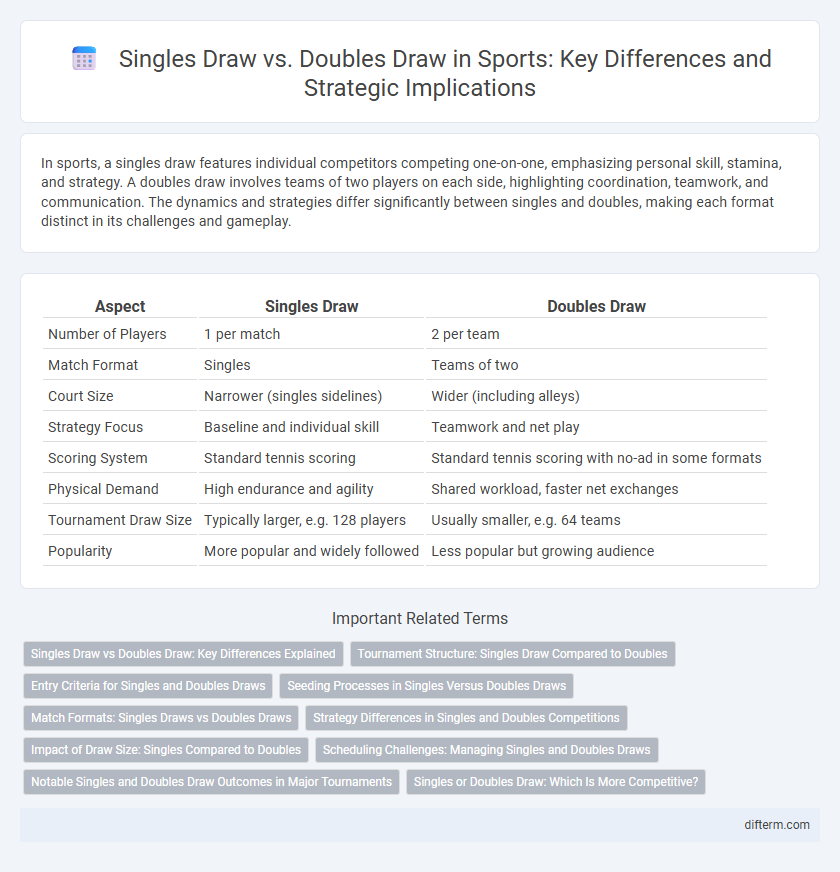In sports, a singles draw features individual competitors competing one-on-one, emphasizing personal skill, stamina, and strategy. A doubles draw involves teams of two players on each side, highlighting coordination, teamwork, and communication. The dynamics and strategies differ significantly between singles and doubles, making each format distinct in its challenges and gameplay.
Table of Comparison
| Aspect | Singles Draw | Doubles Draw |
|---|---|---|
| Number of Players | 1 per match | 2 per team |
| Match Format | Singles | Teams of two |
| Court Size | Narrower (singles sidelines) | Wider (including alleys) |
| Strategy Focus | Baseline and individual skill | Teamwork and net play |
| Scoring System | Standard tennis scoring | Standard tennis scoring with no-ad in some formats |
| Physical Demand | High endurance and agility | Shared workload, faster net exchanges |
| Tournament Draw Size | Typically larger, e.g. 128 players | Usually smaller, e.g. 64 teams |
| Popularity | More popular and widely followed | Less popular but growing audience |
Singles Draw vs Doubles Draw: Key Differences Explained
The singles draw in tennis features individual players competing one-on-one, emphasizing stamina, precision, and personal strategy, while the doubles draw consists of teams of two players per side, requiring coordinated teamwork, communication, and combined tactics. Singles matches generally demand greater court coverage and endurance from each player, whereas doubles prioritize positioning and synchrony to exploit angles and openings. Tournament structures and ranking points differ significantly between singles and doubles draws, reflecting the distinct skill sets and competitive dynamics of each format.
Tournament Structure: Singles Draw Compared to Doubles
In tournament structure, singles draws feature individual competitors competing one-on-one, typically involving a larger field and more rounds to determine a champion. Doubles draws consist of teams of two players, leading to fewer matches and a different strategic dynamic, often resulting in smaller draw sizes. The seeding and progression in singles focus on individual ranking points, while doubles emphasize team coordination and combined rankings, influencing the allocation of spots and match scheduling.
Entry Criteria for Singles and Doubles Draws
Entry criteria for singles draws in sports such as tennis typically prioritize player rankings and qualifying rounds, with direct acceptance granted to top-ranked athletes and wildcards offered to emerging talents. Doubles draws often consider combined team rankings and compatibility, with entry extended to established pairs or those granted wildcards by tournament organizers. Both draws may include alternates and qualifiers to fill vacancies, ensuring competitive balance and adherence to regulations.
Seeding Processes in Singles Versus Doubles Draws
Seeding processes in singles draws rely heavily on individual player rankings, recent performances, and head-to-head statistics to determine placement and avoid early clashes between top contenders. In doubles draws, seeding considers combined team rankings and past partnership results, emphasizing chemistry and coordination alongside individual skills. These tailored seeding criteria ensure balanced competition and strategically spaced matchups in both singles and doubles formats.
Match Formats: Singles Draws vs Doubles Draws
Singles draws in tennis feature individual players competing one-on-one, typically following a best-of-three or best-of-five sets format, emphasizing stamina and individual skill. Doubles draws involve teams of two, where matches often adopt a faster pace with modified scoring systems like no-ad scoring and match tiebreaks to 10 points. The distinct match formats impact strategic play style, court coverage responsibilities, and scoring dynamics unique to singles and doubles competitions.
Strategy Differences in Singles and Doubles Competitions
Singles draw in tennis emphasizes endurance, court coverage, and baseline consistency, requiring players to develop strong individual shot selection and stamina. Doubles draw prioritizes coordination, communication, and net play, with strategies centered around teamwork, quick reflexes, and poaching to control the net. Effective doubles teams use formations like the I-formation or Australian formation to disrupt opponents' rhythm and maximize court coverage.
Impact of Draw Size: Singles Compared to Doubles
The impact of draw size in singles compared to doubles significantly influences match dynamics and player workload, with singles draws typically featuring larger fields that increase the number of matches required to win a tournament. Larger singles draws demand greater physical endurance and strategic planning, whereas smaller doubles draws often lead to more intense, high-stakes matches due to fewer rounds. Tournament organizers must balance draw size to optimize player performance, spectator engagement, and scheduling efficiency across both formats.
Scheduling Challenges: Managing Singles and Doubles Draws
Scheduling challenges in managing singles and doubles draws arise from overlapping match timings and player fatigue, complicating efficient tournament progression. Tournament organizers must balance court availability and recovery periods to ensure fair competition and player performance. Effective scheduling minimizes conflicts, enabling seamless coordination between singles and doubles events while maintaining audience engagement.
Notable Singles and Doubles Draw Outcomes in Major Tournaments
Notable singles draw outcomes in major tennis tournaments often feature top-ranked players facing early-round upsets, significantly impacting championship predictions and ranking points distribution. Doubles draws, highlighted by established pairings and strategic team dynamics, frequently result in surprise finalists and champions due to the unique chemistry and partnership experience required. Major tournaments like Wimbledon and the US Open showcase contrasting trends where singles draws emphasize individual prowess, while doubles draws highlight coordinated teamwork and adaptive playing styles.
Singles or Doubles Draw: Which Is More Competitive?
Singles draws often showcase intense one-on-one rivalries, highlighting individual skill, strategic prowess, and mental toughness, making the matches highly competitive. Doubles draws emphasize teamwork, coordination, and communication, with faster-paced exchanges and unique tactics that test players' adaptability under pressure. Both formats demand peak physical and technical performance, but the intrinsic competitiveness varies based on player dynamics and tournament context.
singles draw vs doubles draw Infographic

 difterm.com
difterm.com